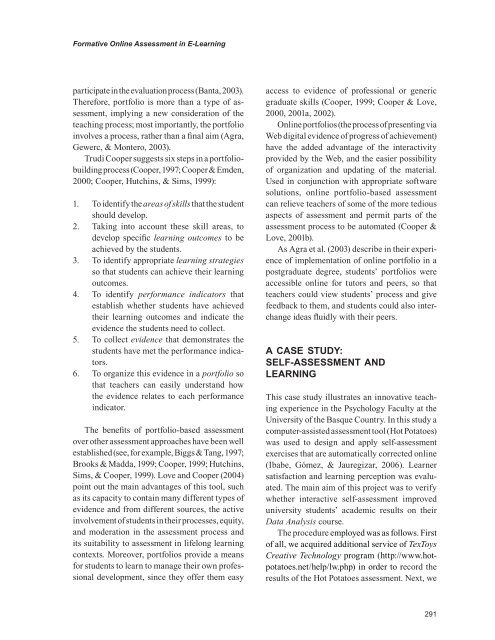Advances in E-learning-Experiences and Methodologies
Create successful ePaper yourself
Turn your PDF publications into a flip-book with our unique Google optimized e-Paper software.
Formative Onl<strong>in</strong>e Assessment <strong>in</strong> E-Learn<strong>in</strong>g<br />
participate <strong>in</strong> the evaluation process (Banta, 2003).<br />
Therefore, portfolio is more than a type of assessment,<br />
imply<strong>in</strong>g a new consideration of the<br />
teach<strong>in</strong>g process; most importantly, the portfolio<br />
<strong>in</strong>volves a process, rather than a f<strong>in</strong>al aim (Agra,<br />
Gewerc, & Montero, 2003).<br />
Trudi Cooper suggests six steps <strong>in</strong> a portfoliobuild<strong>in</strong>g<br />
process (Cooper, 1997; Cooper & Emden,<br />
2000; Cooper, Hutch<strong>in</strong>s, & Sims, 1999):<br />
1. To identify the areas of skills that the student<br />
should develop.<br />
2. Tak<strong>in</strong>g <strong>in</strong>to account these skill areas, to<br />
develop specific learn<strong>in</strong>g outcomes to be<br />
achieved by the students.<br />
3. To identify appropriate learn<strong>in</strong>g strategies<br />
so that students can achieve their learn<strong>in</strong>g<br />
outcomes.<br />
4. To identify performance <strong>in</strong>dicators that<br />
establish whether students have achieved<br />
their learn<strong>in</strong>g outcomes <strong>and</strong> <strong>in</strong>dicate the<br />
evidence the students need to collect.<br />
5. To collect evidence that demonstrates the<br />
students have met the performance <strong>in</strong>dicators.<br />
6. To organize this evidence <strong>in</strong> a portfolio so<br />
that teachers can easily underst<strong>and</strong> how<br />
the evidence relates to each performance<br />
<strong>in</strong>dicator.<br />
The benefits of portfolio-based assessment<br />
over other assessment approaches have been well<br />
established (see, for example, Biggs & Tang, 1997;<br />
Brooks & Madda, 1999; Cooper, 1999; Hutch<strong>in</strong>s,<br />
Sims, & Cooper, 1999). Love <strong>and</strong> Cooper (2004)<br />
po<strong>in</strong>t out the ma<strong>in</strong> advantages of this tool, such<br />
as its capacity to conta<strong>in</strong> many different types of<br />
evidence <strong>and</strong> from different sources, the active<br />
<strong>in</strong>volvement of students <strong>in</strong> their processes, equity,<br />
<strong>and</strong> moderation <strong>in</strong> the assessment process <strong>and</strong><br />
its suitability to assessment <strong>in</strong> lifelong learn<strong>in</strong>g<br />
contexts. Moreover, portfolios provide a means<br />
for students to learn to manage their own professional<br />
development, s<strong>in</strong>ce they offer them easy<br />
access to evidence of professional or generic<br />
graduate skills (Cooper, 1999; Cooper & Love,<br />
2000, 2001a, 2002).<br />
Onl<strong>in</strong>e portfolios (the process of present<strong>in</strong>g via<br />
Web digital evidence of progress of achievement)<br />
have the added advantage of the <strong>in</strong>teractivity<br />
provided by the Web, <strong>and</strong> the easier possibility<br />
of organization <strong>and</strong> updat<strong>in</strong>g of the material.<br />
Used <strong>in</strong> conjunction with appropriate software<br />
solutions, onl<strong>in</strong>e portfolio-based assessment<br />
can relieve teachers of some of the more tedious<br />
aspects of assessment <strong>and</strong> permit parts of the<br />
assessment process to be automated (Cooper &<br />
Love, 2001b).<br />
As Agra et al. (2003) describe <strong>in</strong> their experience<br />
of implementation of onl<strong>in</strong>e portfolio <strong>in</strong> a<br />
postgraduate degree, students’ portfolios were<br />
accessible onl<strong>in</strong>e for tutors <strong>and</strong> peers, so that<br />
teachers could view students’ process <strong>and</strong> give<br />
feedback to them, <strong>and</strong> students could also <strong>in</strong>terchange<br />
ideas fluidly with their peers.<br />
A cAse study:<br />
seLF-Assessment And<br />
LeArnIng<br />
This case study illustrates an <strong>in</strong>novative teach<strong>in</strong>g<br />
experience <strong>in</strong> the Psychology Faculty at the<br />
University of the Basque Country. In this study a<br />
computer-assisted assessment tool (Hot Potatoes)<br />
was used to design <strong>and</strong> apply self-assessment<br />
exercises that are automatically corrected onl<strong>in</strong>e<br />
(Ibabe, Gómez, & Jauregizar, 2006). Learner<br />
satisfaction <strong>and</strong> learn<strong>in</strong>g perception was evaluated.<br />
The ma<strong>in</strong> aim of this project was to verify<br />
whether <strong>in</strong>teractive self-assessment improved<br />
university students’ academic results on their<br />
Data Analysis course.<br />
The procedure employed was as follows. First<br />
of all, we acquired additional service of TexToys<br />
Creative Technology program (http://www.hotpotatoes.net/help/lw.php)<br />
<strong>in</strong> order to record the<br />
results of the Hot Potatoes assessment. Next, we


